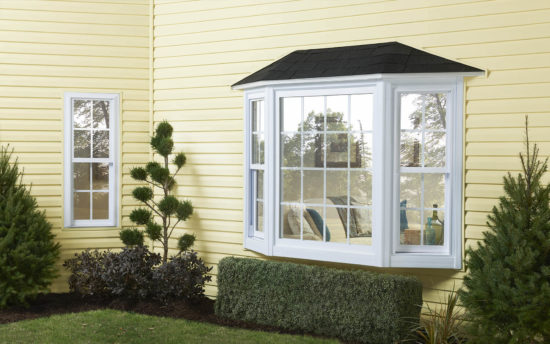When it comes to exterior home materials, vinyl siding is a common choice with nearly 40% of Americans choosing to use it on their homes. Vinyl siding is affordable and durable, and improvements in the quality of the material over the years has unlocked more options for homeowners and reignited its popularity. Vinyl siding now comes in many colors, textures, and sizes for a most customizable look. Because of its affordability, vinyl siding usually results in a great return on investment, making it a favorite of both homeowners and contractors alike.
If you’re not sold yet, in this article, we’ll tell you everything you need to know about vinyl siding.
Vinyl Siding Installation
Installing vinyl siding can be a daunting task, but with eight simple steps, you will be ready to get your house prepared.
Prepare the Exterior
The first thing you want to do is prepare the exterior of your home. Since vinyl siding is installed over an existing structure, you want to make sure you are just not masking problems that may pop up later. All necessary repairs should be made at this time including resealing, replacing decayed wood, caulking problem areas or tightening any loose structures. Once you have completed that, you will want to make sure you remove any type of protrusions that may get in the way. For example, downspouts or light fixtures should be taken down at this time.
Sheath the Walls
Next, you need to sheath the walls and install a moisture barrier. Vinyl siding should not be installed without sheathing, and a material like ½ inch plywood or oriented strand board (OSB) provides a clean, smooth surface for the vinyl.
Soffit and Fascia
After installing the sheathing, you will want to install soffit and fascia siding. This will tie together your eaves and roofing with the siding and usually come in the same color and design.
Measurements
Once placing the soffit and fascia in place, you will measure your walls to come up with the proper number of pieces of siding your wall will require.
Install Starter Strip
Having finished your measurements, it’s time to place your starter strip, where the first piece of siding will begin your project.
Set Up Corner Post
Install these on each corner of the house to run about ¾ of an inch beneath the bottom edge of the starter panel to just below the eaves. Drop your plumb bob regularly to make sure they are completely straight.
Flashing and J-Channel Installation
Finally, you will want to install flashing and j-channel around doors and windows. This will prevent moisture from entering the interior of your home.
Install Siding Panels
Once you have sealed any exterior window or door, it is time to install your siding panels.
The Benefits of Vinyl Siding
Vinyl siding looks great. It comes in a variety of colors and styles, textures and colors. But what are other benefits to installing vinyl siding on your home? First is the low cost of installing vinyl siding as it is more affordable than most siding types.
Another benefit is the variety of color. Vinyl siding comes in a wide range of colors, allowing for maximum customization. Vinyl siding also mimics high-end siding and even can give you the warm richness of wood or stone at a fraction of the price. Plus, vinyl siding is resistant to water damage, pest infestation, and can withstand high winds. Vinyl siding can also be resistant to mold and mildew since well-installed vinyl siding allows moisture to escape, prohibiting mold and mildew to form.
Insulation can be a big benefit of vinyl siding as it reflects radiant heat, reducing thermal conductivity and keeping your home cool and energy efficient. Vinyl siding can also be eco-friendly. Vinyl siding and vinyl siding insulation have a lower environmental impact throughout their lifecycle as compared to other kinds of exterior cladding material. Vinyl siding scrap can also be recycled.
As previously mentioned, vinyl siding is easily installed and helps keep costs at a minimum. Vinyl siding is also low-maintenance, keeping cost of ownership low. Its slick surface allows for easy cleanup, as things such as dust, cobwebs, and other debris slide right off with the squirt of a garden hose.
Finally, vinyl siding is weather resistant. If you live in an area prone to strong storms, there are brands of siding that can withstand winds of up to 240 mph. Depending on the types of siding, you may also be eligible for a reduction in your insurance premiums.
How Much Does Vinyl Siding Cost?
Vinyl is one of the most affordable siding material options available. Siding projects can cost anywhere from a few thousand dollars to $20,000, though the national average sits right under $10,000 for a 1,500 square-foot home. This average includes labor, trim, and other materials needed for the job.
Vinyl siding costs anywhere from $3 to $8.50 per square-foot installed on average. Vinyl siding replacement costs vary depending on factors including the size of your home, local labor rates, and whether you are doing a full or partial vinyl siding installation.
Finding A Professional Vinyl Siding Installer
Siding installation is very labor-intensive, and you want the right people on the job. For a team of experts and customer service that is second to none, look no further than Tom Adams Windows and Carpets.
Tom Adams Windows and Carpets offers ProVia Siding, which excels in elegance and endurance. Their professional-class siding has the look and texture of wood with the durability strength and low maintenance of vinyl. With three types of siding to choose from, including insulated, traditional, and decorative, you can find the right one for your needs, style, and budget.
Tom Adams expert installations provide a lifetime of satisfaction with a five-year labor warranty, or 50-year transferable limited product warranty.
For a free quote or to check out all the options of vinyl siding, check out one of Tom Adams’ four locations or check out our website today.







